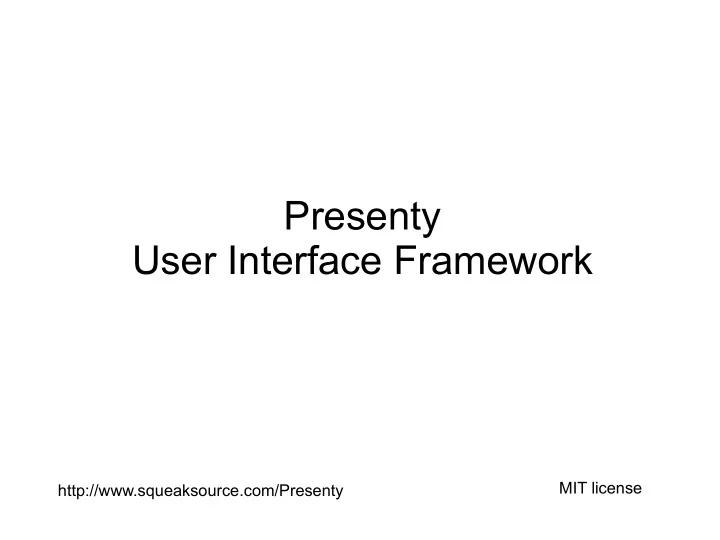

Presenty User Interface Framework MIT license http://www.squeaksource.com/Presenty
Presenty Platform-independent user interface application
Desktop contact manager
Filter contacts by typed name
Select contact from groups
Select contact from last calls
Contact selection show details data
Presenty approach ● Multiple separated tasks a user can perform ● Each task is a sequence of user requests ● Contact groups selection task: 1) select group from groups list 2) select contact from selected group contents 3) look at selected contact details
Implementation ● Continuation-based tasks as elements of user interaction at application level ● User requests as building blocks for tasks: ● Primitive user requests to invoke base interface components ● Compound requests for calling other tasks ● Extendable DSL (pure Smalltalk) facilitating task implementation ● Modified Model-View-Presenter pattern
SelectContactFromGroupsTask body | selected group | group := user select: ContactsGroup from: ContactManager groups. selected := user select: Contact from: group contents. user goTo: (DetailedContactPresenter on: selected )
Select contact from groups
SelectContactBySearchTask body | selected | selected := user execute: ( PtySearchItemTask forItems: ContactManager contacts ofClass: Contact). guide restoreActiveArea. user goTo: (DetailedContactPresenter on: selected )
SelectContactFromLastCallsTask body | selected | selected := user select: 'LastContact' from: ContactManager lastCalls. user goTo: (DetailedContactPresenter on: selected )
ShowContactsForDesktopTask body guide viewport createNewViewArea. guide forkTask: SelectContactFromLastCallsTask new. guide forkTask: SelectContactFromGroupsTask new. guide forkTask: SelectContactBySearchTask new. user goTo: [guide showViewArea]
Select contact from last calls
Select contact from last calls
Select contact from groups
Select contact from groups
Filter contacts by typed name
guide translator
Filter contacts by typed name
Filter contacts by typed name
ShowContactsForPhoneTask body | taskClass | guide viewport createNewViewArea. taskClass := user select: 'ContactManagerTask' from: {SelectContactFromLastCallsTask. SelectContactFromGroupsTask. SelectContactBySearchTask}. guide addBackButton. user execute: taskClass new
Task Configuration ● Presenter can have different views in different contexts ● For different parent presenters ● For different tasks ● For different styles of presenter ● For different styles of parent presenter
Task Configuration ● Guide can store default settings for tasks – guide create: PtyShowListTask ● Task settings can vary in different contexts
How tasks configured ● PtyItemsListTask has itemPresenterFactory which can be saved in settings ● PtyExplicitPresenterFactory specifyed concrete presenter class to present list items ● PtyPresenterPreviewFactory use #preferredPreviewPresenter message for getting presenter from list item
What should be done ● Configurable task activation ● Simple object editor task – user edit: object ● Better designer ● Serializing prototypes and settings to style classes ● Searching for prototypes and settings in multiple task contexts ● Documentation
Questions?
The end
Modal warning example
Tasks from blocks DetailedContactPresenter>>runCall guide executeTask: [ guide doInModal: [ guide user warn: 'You dial to ', model printString]. guide user stopCurrentTask. ] asTask
Presenty UI framework ● Modified Model-View-Presenter pattern ● Continuation-based tasks as elements of user interaction at application level ● User requests as building blocks for tasks: ● Primitive user requests to invoke base interface components ● Compound requests for calling other tasks ● Extendable DSL (pure Smalltalk) facilitating task implementation ● Prototyping for visual components and tasks
Modified Model-View-Presenter pattern
Recommend
More recommend